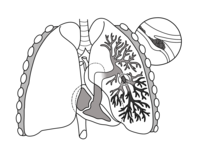
Photo from wikipedia
Pathophysiology, diagnosis and treatment of pleural transudates has widely been described in the literature [1–3]. Except for left heart failure, which requires diuretics, thoracoscopic talc pleurodesis appears to be a… Click to show full abstract
Pathophysiology, diagnosis and treatment of pleural transudates has widely been described in the literature [1–3]. Except for left heart failure, which requires diuretics, thoracoscopic talc pleurodesis appears to be a safe and effective therapeutic option [4–6]. We report the case of a woman who presented with a sudden pleural fluid formation from her parietal pleura during a talc pleurodesis for a recurrent transudative pleural effusion. We discuss the pathophysiology of this phenomenon. Pleural transudative effusion arises from imbalances between the hydrostatic and/or oncotic pressures. Temperature drop following talc poudrage through a spray may accentuate the pressure changes induced by superior vena cava syndrome. http://ow.ly/EpZm30nwVZj
Journal Title: ERJ Open Research
Year Published: 2019
Link to full text (if available)
Share on Social Media: Sign Up to like & get
recommendations!